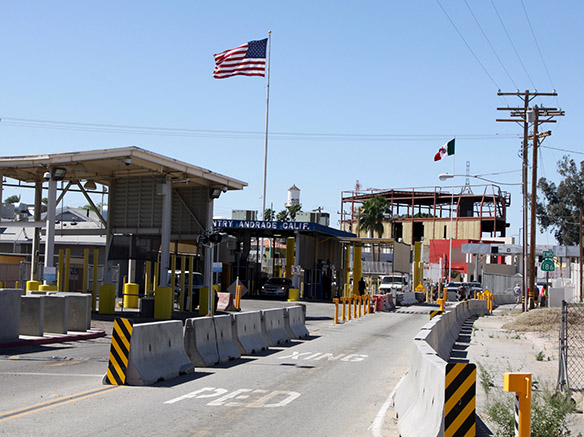 |
| If you’re having trouble reading this, click here. |
 |
| INPUT |
 |
|
|
 |
| Top Takes on Manufacturing, Politics and Policy |
 |
By Rachel Hostyk – April 3, 2019– SHARE


|
 |
 |
|
|
Top Headlines:
|
|
Closing the Border Would Cost Manufacturers |
 |
 |
The NAM is warning policymakers of the high costs of closing the border—and reminding them of the urgent need for a bipartisan, commonsense immigration fix, such as the NAM’s own “A Way Forward” proposal. NAM Chief Economist Chad Moutray laid out the numbers:
- “More than 21,000 manufacturing companies in America export to Mexico.”
- “In 2018, the U.S. exported $265 billion of goods across the Mexico border.”
- “Businesses, including manufacturers and farmers, will lose $726 million every day the border is closed.”
- “The jobs of nearly 1 million American manufacturing workers are related directly to exports to Mexico, and those jobs would be immediately at risk should the border close.”
- “More than 3.3 million American jobs in other sectors of the U.S. economy that have been created as a result of these export-related jobs would also be at risk.”
So what should policymakers consider when confronting our broken immigration system and the current situation at the border? Here are some suggestions from “A Way Forward”:
- “Strengthen border security by building walls, fences and barriers.”
- “Provide a permanent and compassionate solution for populations facing uncertainty, including the Dreamers.”
- “Reform asylum and refugee programs for a more orderly and humane system.”
- “Reform the legal immigration system to help solve America’s growing workforce crisis and better reflect employers’ needs.”
As NAM President and CEO Jay Timmons put it in a statement:
- “The NAM has been to the border to witness the situation firsthand. Congress absolutely must tackle comprehensive immigration reform immediately to address the real national security and humanitarian concerns that are a direct result of our current broken system.”
The NAM’s statement on the border situation and Moutray’s figures have been cited in a number of news outlets, including The Wall Street Journal (subscription), Politico, The Hill, The Washington Times, Market Watch, United Press International, Independent Journal Review and American Shipper. |
|
 |
| This publication is a first look at breaking news, not the last word on anything. For the Official NAM Position on any given policy, please contact the staff leadership.
|
 |
|
Durable Goods Wobbled in February |
 |
 |
Durable goods orders dropped in February after growing over the previous three months, mainly thanks to the volatile aircraft market. More from The Wall Street Journal (subscription):
- “Orders for durable goods—products designed to last at least three years, such as computers and machinery—sank 1.6% in February from January to a seasonally adjusted $250.58 billion, the Commerce Department said Tuesday.”
- “Economists surveyed by The Wall Street Journal had expected a 2.1% decline for the month.”
- “Growth in overall durable-goods orders for January was revised down to a 0.1% increase from a previous estimate of 0.3%. Through the first two months of 2019, durable-goods orders were up 4.4% compared with the same period a year earlier.”
- “A closely watched proxy for business investment, new orders for nondefense capital goods excluding aircraft declined 0.1% in February after rising a revised 0.9% in January, according to Tuesday’s data.”
The Journal concludes on a hopeful note:
- “The better-than-expected data are likely to further ease economists’ worries about a slowdown in growth in 2019, as the manufacturing sector is highly cyclical and is seen as a bellwether for trends in the economic cycle. Financial markets rallied Monday after the Institute for Supply Management said its manufacturing index rose more than expected in March, to 55.3 from 54.2 in February, indicating expansion.”
As I wrote yesterday, the NAM’s Moutray is also cautiously optimistic about this year, explaining to manufacturers that the big picture is more stable than the daily dose of mixed messages makes it seem. |
|
Our Way or the Huawei |
 |
 |
Though the U.S. government is still urging its European allies to keep Huawei out of their 5G networks, American policymakers are dealing with the reality that Huawei is here to stay. Its equipment is already present in the continent’s current networks, and it will likely build at least some of Europe’s next-generation infrastructure. More from The Washington Post (subscription):
- “‘We are going to have to figure out a way in a 5G world that we’re able to manage the risks in a diverse network that includes technology that we can’t trust,’ said Sue Gordon, the deputy to the director of the U.S. intelligence community. ‘We’re just going to have to figure that out.’”
- “Already, officials have begun discussing ways to use encryption, segmented network components and stronger standards to protect key systems. Several years ago, the major U.S. telecom providers began designing into their 5G network features aimed at keeping domestic systems safe from spying and cyberattacks by adversaries and criminals.”
Even though the big U.S. carriers won’t use Huawei for their 5G networks, the global interconnectivity of the internet poses risks:
- “The four major U.S. firms — AT&T, Verizon, Sprint and T-Mobile — have pledged to the U.S. government that they will bar Huawei and another Chinese firm, ZTE, from the 5G networks. But they must still connect with foreign networks, and if they are running Huawei, American traffic will traverse boxes that Huawei controls.”
- “Telecom firms such as AT&T and Verizon have engineered features such as gateways through which all untrusted international traffic must pass to be scrubbed for malware or other forms of attack.”
- “‘The 5G standard is being built with security from its inception, building on lessons learned from previous generations of wireless,’ said one telecom industry official, who spoke on the condition of anonymity because he was not authorized to speak publicly on the issue. ‘And it is an iterative process, so that as problems arise, they can be addressed.’”
This struggle over the future of the internet will affect every facet of the factory and influence manufacturers’ security calculations for decades to come. 5G will enable far more processes and equipment to interact over the internet—opening them up to further risk, especially in supply chains overseas where Huawei has built networks.
Sens. Tom Cotton (R-AR) and John Cornyn (R-TX) wrote an op-ed in The Washington Post (subscription) about the dangers of Chinese-built infrastructure, relating this chilling anecdote:
- “The African Union learned the hard way to be wary of strangers bearing gifts. Its $200 million headquarters in Addis Ababa, Ethiopia, was a ‘gift’ financed, constructed and outfitted by China with Huawei servers.”
- “Last year, African Union engineers alleged those servers had funneled massive amounts of sensitive data to China every night for years — a stunning cybertheft reportedly supplemented by old-fashioned listening devices found in the walls of the Chinese-built facility.”
- “The African Union was forced to replace its servers and implement new security measures at great expense. It declined an offer from Huawei engineers to configure the new system; once burned, twice shy.”
And while we’re on the subject of security risks . . . |
|
Beware the Island-Hoppers |
 |
 |
Hackers are increasingly infiltrating one vulnerable network and then “hopping” to a connected network . . . and then another. The Hill has the story:
- “Researchers for the security firm Carbon Black said in a new report that 50 percent of cyberattacks experienced by its clients during the first quarter of 2019 included the technique, in which hackers will access one network and then spread out by infiltrating other connected networks.”
- “‘At this point, it’s become part and parcel of a cyber crime conspiracy,’ Tom Kellermann, Carbon Black’s chief cybersecurity officer, said in the report. ‘They’re using their victim’s brand against customers and partners of that company. They’re not just, say, invading your house — they’re setting up shop there, so they can invade your neighbors’ houses too.’”
- “Firms working within the financial industry were most likely to report seeing the tactic, with 47 percent reporting incidents of island hopping.”
- “‘. . . The adversary is going after the weakest link in the supply chain to get to their actual target,’ Thomas Brittain, the head of Carbon Black’s global incident response partner program, said in the report. ‘Businesses need to be mindful of companies they’re working closely with and ensure that those companies are doing due diligence around cybersecurity as well.’”
This is nearly the last chance to sign up (or sign your CTO or CIO up) for the NAM’s Leading Edge Cybersecurity Forum (co-sponsored by PwC and eSentire), happening in Chicago next week. It’s a great place to learn about how to secure your own operations and your supply chain. |
 |
| Industry Headlines |
 |
|
|
 |
| NAM News |
 |
- Read NAM Vice President of Infrastructure, Innovation and Human Resources Policy Robyn Boerstling on how new health care mandates would burden manufacturers.
- The Wall Street Journal (subscription) cites the NAM’s efforts to reform the proxy advisory process.
- Law360 (subscription) writes about the NAM’s amicus brief (with partners) in support of Intel in a dispute over the limitations for Employee Retirement Income Security Act claims.
|
 |
|
If you’re part of an NAM member company and not yet subscribed, email us. If you’re not an NAM member, become a member today.
|
|
|
|
 |
|
|
|
 |
|
|